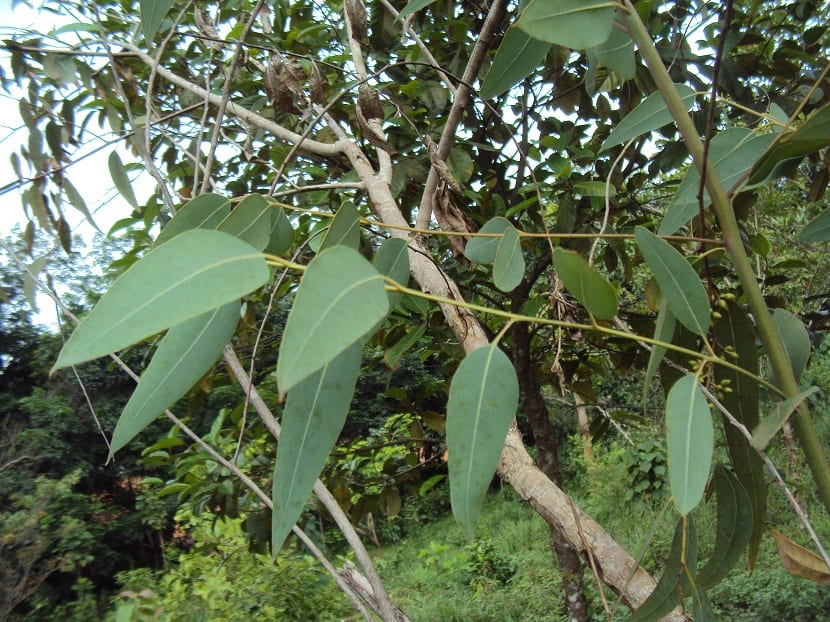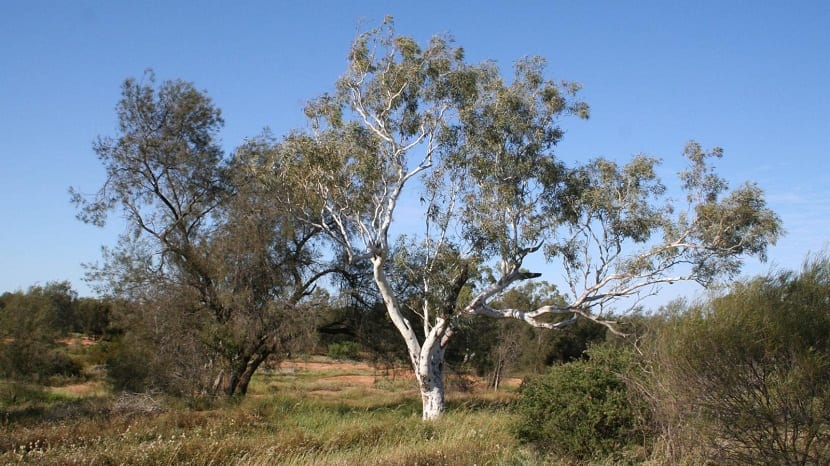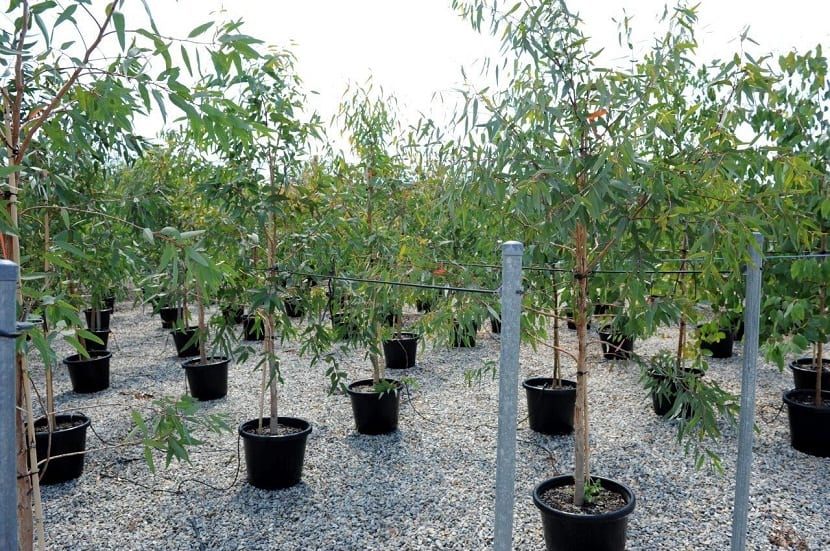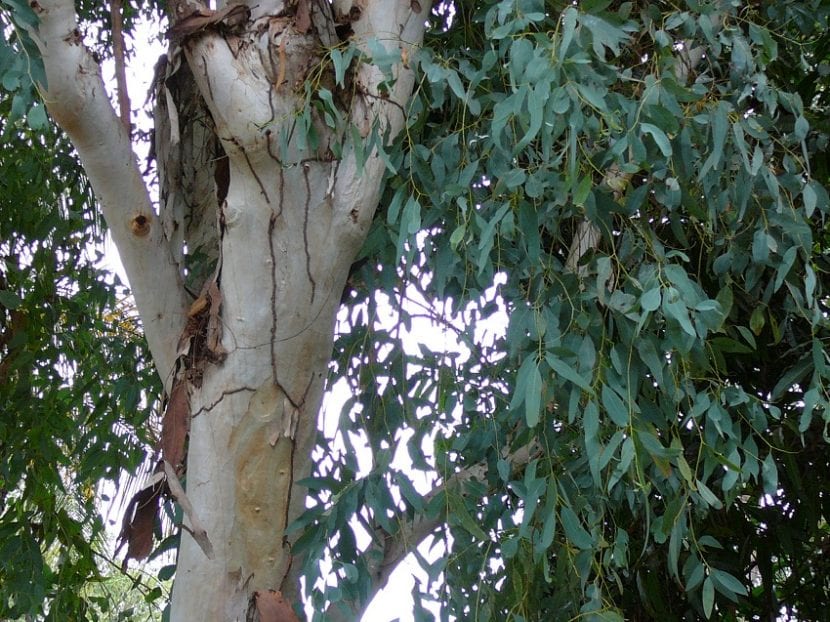
Native to Australia but widespread in many parts of the world, this arboreal species also called red eucalyptus and evergreen treeIt belongs to the Eucalypto genus of the Myrtaceae family and is characterized by its large size and height reaching 60 meters.
Throughout its life in good water and temperature conditions, the diameter can reach two meters. Its bark is smooth and bluish-green or green.. With a wide crown and a very thick trunk, its surface peels off in plates over the years and sometimes completely.
Features

This tree is often found as its natural habitat on the banks of rivers or streams. It blooms in winter coinciding with the Australian spring and its flowers are grouped in number from 7 to 10 with a conical cap that when detached, it reveals a quantity of stamens off-white in color.
Its flowering period is quite long with a limit until the end of spring. Due to its large volume and development not recommended for gardens and urban areas, since it requires large spaces with great amplitude for its free expansion and development, coupled with the fact that due to its innate aggressiveness it causes the impoverishment of the soils.
It is the eucalyptus species with the most extensive area of dissemination in continental Australia, where it is an icon, presenting great genetic variability. It grows in temperate climates with winter rains, and to the south to tropical with summer rains in the north.
Outside of Australia it is perhaps the largest of the eucalyptus species planted in arid or semi-arid areas and that withstands extreme drought conditions as well as floods, in addition, to adapt also to maritime climates.
Supports the presence of lime in the soil up to a certain point, since if it is excessive it produces chlorosis, a disease typical of plants that, due to the lack of salts, causes the loss of the green color. With an adaptability that reveals its elasticity, it can be planted anywhere in the world.
It spreads through its seeds, not by cuttings.
Cultivation of eucalyptus camaldulensis

In Spain it is widely cultivated, being the second most important and abundant variety with an expansion in planted hectares of 175.000 and spread throughout the country.
Although they were introduced in the XNUMXth century it was not until the twentieth century when they spread massively. The provinces that stand out for having this species on their soil are: Cáceres, Badajoz, Huelva, Seville, Toledo, Ciudad Real, Córdoba, Cádiz and Málaga.
The controversy did not wait for the massive introduction of this species in this country, with supporters and detractors, considering the most radical that the arrival of this tree to Spanish lands was one of the worst forestry initiatives of those that are remembered in Spanish history.
Currently, plantations continue to be an obstacle in the conservation of flora and fauna, in addition to the fact that because it is a pyrophyte plant, this means that it facilitates the spread of forest fires because it is a fuel generator and due to its large size, aggravates a fire situation that added to the other factors runs the risk of becoming an uncontrollable forest fire in many cases.
The name makes a direct allusion to the flower of this tree that is well protected until it opens by the sepals camaldulis, which refers to the Italian garden of Naples with that name.
When it is a young plant, the eucalyptus has elongated leaves with a pointed apex without hairs, unlike adulthood in which these leaves become wide and with the pointed apex.
With small, whitish flowers arranged in pedunculated axillary umbels in the axils of the leaves, it is actually a fast-growing species that stands out for its great capacity to adapt to climate variability.
Its development has spread throughout much of Argentina from the Province of Rio Negro to the north, thus integrating afforestation of massifs or curtains and repair mountains, being its presence very important in the province of Buenos Aires, Santa Fe and Jujuy.
Because of its high size produces good shade in extreme temperature regions as is the case in central Australia, where it also serves as a river bank stabilizer and retains the soil.
It is a timber tree species included in the so-called exotics, and taking into account that the world's forests are being cut down, and the fact that the growing demand for wood for industrial use and to meet fuel needs in developing countries with growing populations are on the rise, it is a species that does not contribute to the environment.
The planting of species such as the Eucalyptus camaldulensis, which is among the more than 600 varieties of this same genus due to its rapid growth and its multiple uses, from the wood itself, to a series of environmental, medicinal and ornamental uses.
However, there are adverse opinions to this growing popularity that encourage the planting of these trees, the argument as valid as the previous one refers to the short and long term damage that these species cause to the soil, including the environment and the availability of water and wildlife.
Such is the situation that some countries have already expressly prohibited the planting of eucalyptus trees, since the drying power of the species is such that can transform already semi-arid terrain into drier, sometimes being used to dry out swamps.
Services

However and despite these controversies, there is no doubt that the medicinal benefits provided by eucalyptus are irrefutable. In the foreground The essential oil that is extracted from these trees is extremely useful in respiratory ailments in its internal use and by inhalation, and has antiseptic properties in the case of conditions in the bronchi and lungs. It also serves as a deodorant, anthelmintic, astringent, expectorant, febrifuge, hypoglycemic, mucolytic, bactericidal, fungicidal and bacteriostatic.
In its application and external use we find that its properties are also wide, as they serve in the case of anti-inflammatory, antiseptic, healing, eczema, vulvovaginitis, wounds, skin irritation and even mouth infections, apart from combating halitosis or bad breath.
As if that were not enough, it relieves headaches, tones the nervous system and comes in the form of a lotion to be used on cuts, preventing the appearance of germs and infections. The primary factor for all these beneficial qualities is that these leaves They have antiseptic and balsamic virtues.
As a bactericide, it has been found that eucalyptus has the ability to eliminate and prevent the growth and development of bacteria that are normally found on our skin and nose, as is the case with staphylococci and mycobacterium.
As an anti-inflammatory it is indicated to do steam baths with the leaves of this plant, thus managing to relieve aches and pains caused by diseases such as rheumatism and arthritis.
In the case of antiseptics, its qualities are remarkable in relieving and healing acne and irritations of another nature on the skin.
Camaldolese eucalyptus have the particularity of condensing the humidity of the environment in their leaves, the drops fall to the ground, their roots are at ground level covered with their dry leaves, so they can feed themselves, they can be found in semi-arid areas where rains hardly they reach 400 mm and survive without care, it is a total survivor.-
Hello Jorge.
Very interesting, thanks.
Greetings.